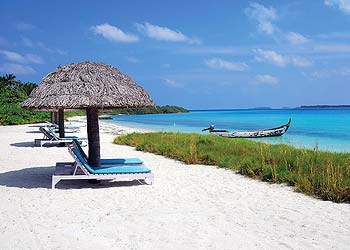Lakshadweep Travel Guide:

Introduction
Lakshadweep is a group of islands in the Laccadive Sea, 200 to 440 km off the coast of the South West Indian state of Kerala. The islands form the smallest Union Territory of India. The total land area is 11 sq mi or 32 km². Ten of the islands are inhabited. Lakshadweep is the northern part of the erstwhile Lakshadweepa. The islands are the northernmost among the Lakshadweep-Maldives-Chagos group of islands, which are actually the tops of a vast undersea mountain range, in the Indian Ocean and the Arabian Sea.
Although the land area is extremely small, if the lagoon area of about 4200 km2. is taken into account, then with a 20,000 km2. of territorial waters and about 4 lakhs km2 (400,000 km2). of economic zone, Lakhshadweep is truly a large territory indeed.
Etymology
Lakshadweep, comes from Lakshadweepa, which literally means one hundred thousand islands (????? dweepa) in Sanskrit. It is the least populous Union Territory of India
History
The earliest references to the islands is made in Puranuru as part of the ancient Tamil (Dravidian) country, Tamilakam. Little else is known about the early history of the Lakshadweep islands. There are references to the control of the islands by the Cheras in the Sangam literature Pathitruppaththu. A Pallava inscription of 7th century AD refers to the islands as Dveepa Laksham and lists them as part of the Pallava domain. Local traditions and legends attribute the first settlement on these islands to the period of Cheraman Perumal, the last Chera king of Kerala. The oldest inhabited islands in the group are Amini,((Kalpeni)) Andrott, Kavaratti and Agatti. Lakshadweep islanders were originally Hindus who later converted to Islam in the 14th century. However, recent archaeological evidence has established that Buddhist settlements also had existed in the islands as early as the 6th or 7th century. According to popular tradition, Islam was brought to Lakshadweep by an Arab named Ubaidulla in 41 (661 AD). His grave is located in the island of Andrott. Muslim grave stones dated to 139 (756 AD) have also been discovered here. During the 11th century, the islands came under the rule of the Late Cholas.
In the 17th century, the islands came under the rule of Ali Rajahs/Arakkal Bheevi of Kannur, who received them as a gift from the Kolathiris. The Portuguese took control to exploit coir production until the islanders expelled the Portuguese. The islands are also mentioned in great detail in the stories of the Arab traveller Ibn Batuta.
The Amindivi group of islands came under the rule of Tipu Sultan in 1787. They passed to British control after the Third Anglo-Mysore War and were attached to South Canara. The rest of the islands came under the suzerainty of the Arakkal family of Cannanore in return for a payment of annual tribute. After a while, the British took over the administration of those islands for non-payment of arrears. These islands were attached to the Malabar district of the Madras Presidency. In 1956, despite the fact that most of the Islanders were Malayalis, the States Reorganisation Act separated these islands from the mainland administrative units, forming a new union territory by combining all the islands.
Politics
Lakshadweep forms a single Indian district and is governed by an administrator appointed by the central government of India. The union territory comes under the jurisdiction of the Kerala High Court at Ernakulam. The territory elects one member to the Lok Sabha (lower house of the Parliament of India). There is no local government at the moment but the administration plans to introduce a two-tiered system based on the Panchayati raj. There will be ten island councils for the inhabited islands (with a total of 79 members).
Economy
Lakshadweep's gross state domestic product for 2004 is estimated at US$60 million at current prices. Coconut fibre extraction and production of fibre products is Lakshadweep's main industry. There are five coir fibre factories, five production demonstration centres and seven fibre curling units run by the government of India. These units produce coir fibre, coir yarn, curled fibre and corridor mattings.
Tourism
Due to its isolation and scenic appeal, Lakshadweep is emerging as a major tourist attraction for Indians. This brings in significant revenue, which is likely to increase. Since such a small region cannot support industries, the government is actively promoting tourism as a means of income. Water sports activities such as scuba diving, wind surfing, snorkelling, kayaking, canoeing, water skiing, yachting and night-voyage into sea are adventurous as well as quite popular among tourists. Hundreds of varieties of living corals, dolphins, sea turtles, sea urchins, seabirds, seaweeds, sea cucumbers, starfish, cowry, clams, eels, swordfish, octopus and innumerable types of lagoon triggerfish, etc. are a real delightful treat to the eyes of a naturalist. Tourists flock these islands throughout the year except during the South-west monsoon months when sea is extremely rough.
Transport
Agatti Aerodrome on Agatti Island is currently the only airport in Lakshadweep. Indian Airlines, the state-owned carrier, serves Agatti and flies to Kochi on the mainland. Also, from April 2007, a private carrier, Kingfisher Airlines, has commenced flights to and from Agatti. Kingfisher connects Kochi and Bangalore to Agatti. The other islands are linked by the Pawan Hans helicopter or boat service.
Ships are the major means of transportation for the islanders. Ships are operated from either Kochi, Mangalore or Beypore (Calicut). There are around 5 passenger ships, but generally only two at a time operate. Advance bookings are required. Sailing schedules are arranged so that each island gets priority at some time of the year. There are vessels operating between some of the larger islands like Kavaratti, Androth, Kalpeni etc., but sailings are affected by weather conditions.
Agriculture
Coconut is the main crop cultivated in the islands. Lakshadweep is India's largest producer of coconuts. About 2,598 hectares are under coconut cultivation and the productivity per hectare is 22,310. Coconuts cultivated in the Lakshadweep are also rich in coconut oil.